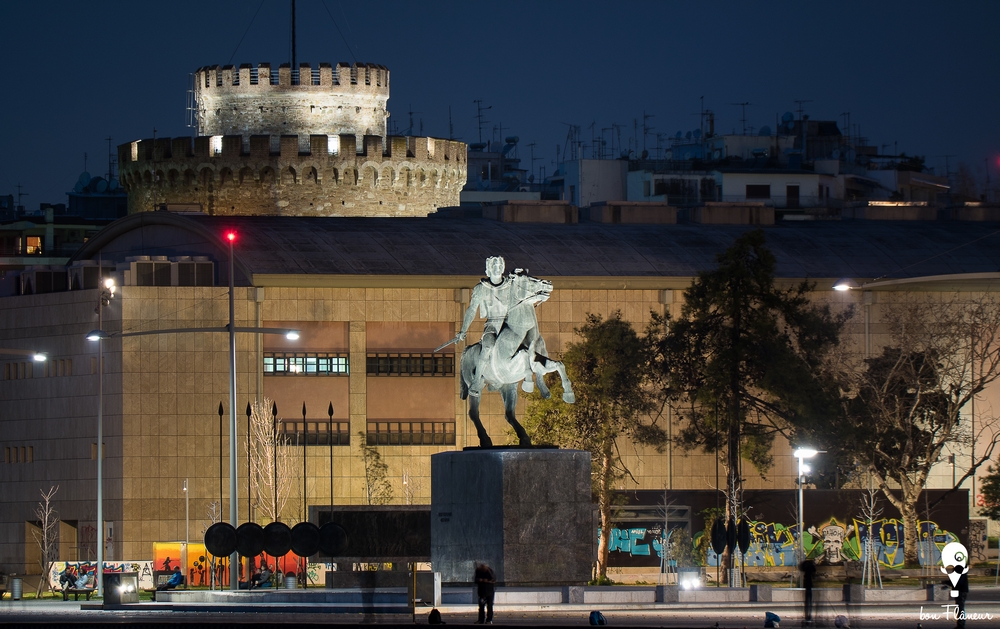Alexander the Great
Equestrian statue of the Greek commander, Alexander the Great.
Location
Timeline
Modern and Contemporary era (1912 - )
1974 Unveiled in the last year of the seven-year dictatorship.

Equestrian statue of the Greek commander, Alexander the Great.
Home > Thessaloniki > Culture > Modern art/ sculpture > Centre > Alexander the Great






The equestrian statue of Alexander the Great dominates the seafront of Thessaloniki, near the park of the YMCA. It is an impressive bronze complex and one of the largest public sculptures in the country, standing at 6.15 metres high. The main sculpture represents the Macedonian king on his favourite horse Bucephalus, who is depicted nervous and raised. Alexander is alert, holding the animal’s reins with ease and cradling his sword. Surrounding him, are a bronze frieze with reliefs depicting his famous expedition as well as Macedonian shields and sarisas, the long Macedonian spears. These days, the marble base is a meeting place for young Thessalonians, near the seafront.
The sculpture is a work by Evangelos Moustakas and was unveiled here toward the end of the seven-year dictatorship. Its commission is indicative of the authorities’ socio-political mentality during that period when historical facts and dominant personalities from antiquity and the 1821 Greek Revolution were used extensively for propaganda purposes, mainly to forge the cohesion of a national identity and a historical continuity of the Greek nation. Even today, nationalists see in the sculpture a symbol of a “Greek cultural superiority”,the State’s military power and a symbol of an aspiration to reclaim formerly Greek territories in the East, hence, the statue facing east. A commemoration of the Macedonian commander’s victories which was held by a conservative political party here a few years ago was indicative of these tendencies. Similar sculptures, as well as ideas, exist in neighbouring North Macedonia, a country that had claimed the name “Macedonia” and its history since the early 1990s in order to create a unified national identity between its Slavic and Albanian inhabitants. This had brought up tensions between the two neighbouring countries, which ended in 2018 in the Prespa Agreement, in an attempt to co-operate and eliminate their differences. The Prespa Agreement provoked reactions in both countries. The statue of Alexander was the meeting point of those who participated in rallies against the agreement.
Zafeiris Ch., (1997), ΘεσσαλονίκηςΕγκόλπιον, ιστορία, πολιτισμός, ηπόλησήμερα, γεύσεις, μουσεία, μνημεία, διαδρομές, [Thessaloniki Handbook, history, culture, the city today, flavours, museums, routes], Athens: Exantas
Orfanidis D., (2016), Υπαίθρια Γλυπτά της Θεσσαλονίκης, παράμετροι υποβάθμισης και φθοράς των υλικών τους, Διπλωματική Εργασία, [Outdoor Sculptures of Thessaloniki, parameters of degradation and wear of their materials], A.U.Th.
Unsigned, (2008), Συλλαλητήριο ΛΑΟΣ με “Ρωμιοσύνη”, αλλά χωρίς βουλευτές και όγκο, [LAOS demonstration with “Romiosyni”, but without MPs and massiveness] in Καθημερινή,
http://www.kathimerini.gr/315578/article/epikairothta/politikh/syllalhthrio-laos-me-rwmiosynh-alla-xwris-voyleytes-kai-ogko
Last visit 20/3/2014
1974 Unveiled in the last year of the seven-year dictatorship.
Share